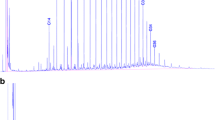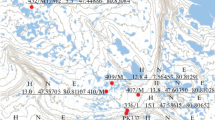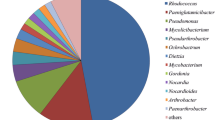Abstract
The use of indigenous bacterial strains is a valuable bioremediation strategy for cleaning the environment from hydrocarbon pollutants. The isolation and selection of hydrocarbon-degrading bacteria is therefore crucial for obtaining the most promising strains for site decontamination. Two different media, a minimal medium supplemented with a mixture of polycyclic aromatic hydrocarbons and a MS medium supplemented with triphenyltetrazolium chloride, were used for the isolation of bacterial strains from two hydrocarbon contaminated soils and from their enrichment phases. The hydrocarbon degradation abilities of these bacterial isolates were easily and rapidly assessed using the 2,6-dichlorophenol indophenol assay. The diversity of the bacterial communities isolated from these two soil samples and from their enrichment phases was evaluated by the combination of a bacterial clustering method, fluorescence ITS-PCR, and bacterial identification by 16S rRNA sequencing. Different PCR-based assays were performed in order to detect the genes responsible for hydrocarbon degradation. The best hydrocarbon-degrading bacteria, including Arthrobacter sp., Enterobacter sp., Sphingomonas sp., Pseudomonas koreensis, Pseudomonas putida and Pseudomonas plecoglossicida, were isolated directly from the soil samples on minimal medium. The nahAc gene was detected only in 13 Gram-negative isolates and the sequences of nahAc-like genes were obtained from Enterobacter, Stenotrophomonas, Pseudomonas brenneri, Pseudomonas entomophila and P. koreensis strains. The combination of isolation on minimal medium with the 2,6-dichlorophenol indophenol assay was effective in selecting different hydrocarbon-degrading strains from 353 isolates.


Similar content being viewed by others
References
Afzal M, Yousaf S, Reichenauer TG, Sessitsch A (2012) The inoculation method affetcs colonization and performance of bacterial inoculant strains in the phytoremediation of soil contaminated with diesel oil. Int J Phytoremediation 14:35–47
Andreoni V, Cavalca L, Rao MA, Nocerino G, Bernasconi S, Dell’Amico E, Colombo M, Gianfreda L (2004) Bacterial communities and enzyme activities of PAHs polluted soils. Chemosphere 57:401–412
Baida N, Yazourh A, Singer E, Izard D (2001) Pseudomonas brenneri sp. nov., a new species isolated from natural mineral waters. Res Microbiol 152:493–502
Baldwin BR, Nakatsu CH, Nies L (2003) Detection and enumeration of aromatic oxygenase genes by multiplex and real-time PCR. Appl Environ Microbiol 69:3350–3358
Chadhain SMN, Norman RS, Pesce KV, Kukor JJ, Zylstra GJ (2006) Microbial dioxygenase gene population shifts during polycyclic aromatic hydrocarbon biodegradation. Appl Environ Microbiol 72:4078–4087
Chauhan A, Fazlurrahman F, Oakeshott JG, Jain RK (2008) Bacterial metabolism of polycyclic aromatic hydrocarbons: strategies for bioremediation. Indian J Microbiol 48:95–113
Ciric L, Philp JC, Whiteley AS (2010) Hydrocarbon utilization within a diesel-degrading bacterial consortium. FEMS Microbiol Lett 303:116–122
El Fantroussi S, Agathos SN (2005) Is bioaugmentation a feasible strategy for pollutant removal and site remediation? Curr Opin Microbiol 8:268–275
Fernández-Luqueño F, Valenzuela-Encinas C, Marsch R, Martínez-Suárez C, Vázquez-Núñez E, Dendooven L (2011) Microbial communities to mitigate contamination of PAHs in soil—possibilities and challenges: a review. Environ Sci Pollut Res 18:12–30
Guo C, Dang Z, Wong Y, Tam NF (2010) Biodegradation ability and dioxgenase genes of PAH-degrading Sphingomonas and Mycobacterium strains isolated from mangrove sediments. Int Biodeterior Biodegradation 64:419–426
Haritash AK, Kaushik CP (2009) Biodegradation aspects of polycyclic aromatic hydrocarbons (PAHs): a review. J Hazard Mater 169:1–15
Iwai S, Johnson TA, Chai B, Hashsham SA, Tiedje JM (2011) Comparison of the specificities and efficacies of primers for aromatic dioxygenase gene analysis of environmental samples. Appl Environ Microbiol 77:3551–3557
Jain PK, Gupta VK, Pathak H, Lowry M, Jaroli DP (2010) Characterization of 2T engine oil degrading indigenous bacteria, isolated from high altitude (Mussoorie). India World J Microbiol Biotechnol 26:1419–1426
Jirasripongpun K (2002) The characterization of oil-degrading microorganisms from lubricating oil contaminated (scale) soil. Lett Appl Microbiol 35:296–300
Juhasz AL, Naidu R (2000) Bioremediation of high molecular weight polycyclic aromatic hydrocarbons: a review of the microbial degradation of benzo[a]pyrene. Int Biodeterior Biodegradation 45:57–88
Kimura M (1980) A simple method for estimating evolutionary rates of base substitutions through comparative studies of nucleotide sequences. J Mol Evol 16:111–120
Know SW, Kim JS, Park IC, Yoon SH, Park DH, Lim CK, Go SJ (2003) Pseudomonas koreensis sp. nov., Pseudomonas umsongensis sp. nov. and Pseudomonas jinjuensis sp. nov., novel species from farm soils in Korea. Int J Syst Evol Microbiol 53:21–27
Koma D, Hasumi F, Chung SY, Kubo M (2003) Biodegradation of n-alkylcyclohexanes by co-oxidation via multiple pathways in Acinetobacter sp. ODDK71. J Biosci Bioeng 95:641–644
Kraková L, Chovanová K, Selim SA, Simonovicová A, Puskarová A, Maková A, Pangallo D (2012) A multiphasic approach for investigation of the microbial diversity and its biodegradative abilities in historical paper and parchment documents. Int Biodeterior Biodegradation 70:117–125
Kubota K, Koma D, Matsumiya Y, Chung S-Y, Kubo M (2008) Phylogenetic analysis of long-chain hydrocarbon-degrading bacteria and evaluation of their hydrocarbon-degradation by the 2,6-DCPIP assay. Biodegradation 19:749–757
Kurkela S, Lehvaslaiho H, Palva ET, Teeri TH (1988) Cloning, nucleotide sequence and characterization of genes encoding naphthalene dioxygenase of Pseudomonas putida strain NCIB9816. Gene 73:355–362
Lane DJ (1991) 16S/23S rRNA sequencing. In: Stackenbrandt E, Goodfellow M (eds) Nucleic acid techniques in bacterial systematics. Wiley, New York, pp 115–148
Laurie AD, Lloyd-Jones G (2000) Quantification of phnAc and nahAc in contaminated New Zealand soils by competitive PCR. Appl Environ Microbiol 66:1814–1817
Li X, Li P, Lin X, Zhang C, Li Q, Gong Z (2008) Biodegradation of aged polycyclic aromatic hydrocarbons (PAHs) by microbial consortia in soil and slurry phases. J Hazard Mater 150:21–26
Ma YF, Liu XL, Shao ZZ (2005) Isolation of phenanthrene-degrading bacteria and analysis of their degrading-enzyme gene. Chin J Appl Environ Biol 11:218–221
Madueño L, Coppotelli BM, Alvarez HM, Morelli IS (2011) Isolation and characterization of indigenous soil bacteria for bioaugmentation of PAH contaminated soil of semiarid Patagonia. Argentina Int Biodeterior Biodegradation 65:345–351
Maliszewska-Kordybach B, Smreczak B, Klimkowicz-Pawlas A (2009) Concentrations, sources, and spatial distribution of individual polycyclic aromatic hydrocarbons (PAHs) in agricultural soils in the Eastern part of the EU: Poland as a case study. Sci Total Environ 407:3746–3753
Máthé I, Benedek T, Táncsics A, Palatinszky M, Lányi S, Márialigeti K (2012) Diversity, activity, antibiotic and heavy metal resistance of bacteria from petroleum hydrocarbon contaminated soils located in Harghita County (Romania). Int Biodeterior Biodegradation 73:41–49
Nishimori E, Kita-Tsukamoto K, Wakabayshi H (2000) Pseudomonas plecoglossicida sp. nov., the causative agent of bacterial haemorrhagic ascites of ayu, Plecoglossus altivelis. Int J Syst Evol Microbiol 50:83–89
Pangallo D, Chovanova K, Drahovska H, De Leo F, Urzi C (2009) Application of fluorescence internal transcribed spacer-PCR (f-ITS) for the cluster analysis of bacteria isolated from air and deteriorated fresco surfaces. Int Biodeterior Biodegradation 63:868–872
Parellada EA, Ramos AN, Ferrero M, Cartagena E, Bardón A, Valdez JC, Neske A (2011) Squamocin mode of action to stimulate biofilm formation of Pseudomonas plecoglossicida J26, a PAHs degrading bacterium. Int Biodeterior Biodegradation 65:1066–1072
Petrović O, Knežević P, Marković J, Rončević S (2008) Screening method for detection of hydrocarbon-oxidizing bacteria in oil-contaminated water and soil specimens. J Microbiol Methods 74:110–113
Powell SN, Singleton DR, Aitken MD (2008) Effects of enrichment with salicylate on bacterial selection and PAH mineralization in a microbial community from a bioreactor treating contaminated soil. Environ Sci Technol 42:4099–4105
Saitou N, Nei M (1987) The neighbour-joining method: a new method for reconstructing phylogenetic trees. Mol Biol Evol 4:406–425
Samanta SK, Singh OV, Jain RK (2002) Polycyclic aromatic hydrocarbons: environmental pollution and bioremediation. Trends Biotechnol 20:243–248
Silva IS, dos Santos EC, de Menezes CR, de Faria AF, Franciscon E, Grossman M, Durrant LR (2009) Bioremediation of a polyaromatic hydrocarbon contaminated soil by native soil microbiota and bioaugmentation with isolated microbial consortia. Bioresour Technol 100:4669–4675
Stach JEM, Burns RG (2002) Enrichment versus biofilm culture: a functional and phylogenetic comparison of polycyclic aromatic hydrocarbon-degrading microbial communities. Environ Microbiol 4:169–182
Stolz A (2009) Molecular characteristics of xenobiotic-degrading sphingomonads. Appl Microbiol Biotechnol 81:793–811
Taccari M, Milanovic V, Comitini F, Casucci C, Ciani M (2012) Effects of biostimulation and bioaugmentation on diesel removal and bacterial community. Int Biodeterior Biodegradation 66:39–46
Toledo FL, Calvo C, Rodelas B, González-López J (2006) Selection and identification of bacteria isolated from waste crude oil with polycyclic aromatic hydrocarbons removal capacities. Syst Appl Microbiol 29:244–252
Tyagi M, da Fonseca MMR, de Carvalho CCCR (2011) Bioaugmentation and biostimulation strategies to improve the effectiveness of bioremediation processes. Biodegradation 22:231–241
Vodovar N, Vinals M, Liehl P, Basset A, Degrouard J, Spellman P, Boccard F, Lemaitre B (2005) Drosophila host defense after oral infection by an entomopathogenic Pseudomonas species. Proc Natl Acad Sci USA 102:11414–11419
Wentzel A, Ellingsen T, Kotlar H-K, Zotchev S, Throne-Holst M (2007) Bacterial metabolism of long-chain n-alkanes. Appl Microbiol Biotechnol 76:1209–1221
Wilson MS, Bakermans C, Madsen EL (1999) In situ, real-time catabolic gene expression: extraction and characterization of naphthalene dioxygenase mRNA transcripts from groundwater. Appl Environ Microbiol 65:80–87
Yousaf S, Ripka K, Reichenauer T, Andria V, Afzal M, Sessitsch A (2010) Hydrocarbon degradation and plant colonization by selected bacterial strains isolated from Italian ryegrass and birdsfoot trefoil. J Appl Microbiol 109:1389–1401
Acknowledgments
This study was supported by project ITMS-26240220010, “New microbial isolates containing the genes of catabolic and detoxification pathways and their use in biotechnology”. We thank Dr. Jacob Bauer for helpful discussions and critical reviews of the manuscript.
Author information
Authors and Affiliations
Corresponding author
Rights and permissions
About this article
Cite this article
Bučková, M., Puškarová, A., Chovanová, K. et al. A simple strategy for investigating the diversity and hydrocarbon degradation abilities of cultivable bacteria from contaminated soil. World J Microbiol Biotechnol 29, 1085–1098 (2013). https://doi.org/10.1007/s11274-013-1277-5
Received:
Accepted:
Published:
Issue Date:
DOI: https://doi.org/10.1007/s11274-013-1277-5




